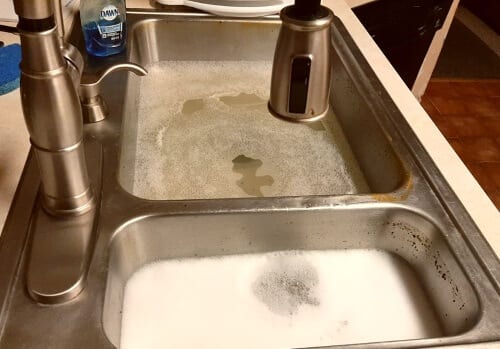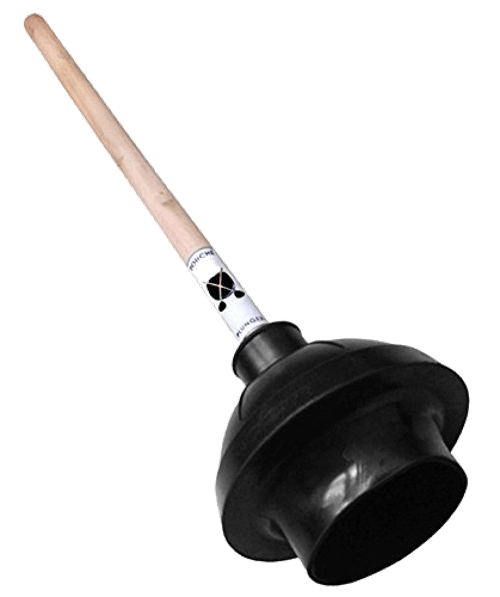The Best Way To Unclog A Drain
Why wait to find out more about drain cleaning?

Jerry’s Plumbing & Heating
15 July 2019
You’re probably standing over a clogged drain right now. Well, maybe not. Still, you’re obviously curious about the best way to unclog a drain. So why wait to find out more about drain cleaning?
In the previous article in our drain cleaning series,
Read More: The Basics Of Unclogging A Drain
, we discussed your drain/sewer system and some things to try when it gets clogged.Let’s just briefly cover unclogging the three basic types of drains in your home: sinks, tubs/showers, toilets.
No matter which drain is clogged, if you intend to try a DIY solution, there are some things you should do to prepare.
Before you Unclog a Drain




While you’re at it, you might as well wear old clothes. You’re likely to get dirty and wet.
Next, protect your house. Spread out paper towels on the floor to soak up any liquids that may splash while you’re working. And turn on the ventilation fan or open a window to vent any fumes that may emanate from the clogged drain.
Now that you’re ready, let’s begin.
“If you move on to using a plunger, make sure you’re using the right type.”


Unclogging a Sink Drain
If possible, start by bailing out whatever water you can from the sink. If you plan to start with hot or boiling water, it works better if you pour straight down the drain rather than through standing water. The same goes if you want to use vinegar and baking soda, baking soda and salt or dish washing liquid.
Remove the stopper or drain plug if you can. A bathroom stopper, controlled by a little rod near the faucet, isn’t that difficult to remove if you can get easy access to it.


You’ll need to seal the sink overflow outlet with duct tape or a damp rag. Otherwise, the air pressure from the plunger will escape out the overflow rather than press down against the clog.
An inch or so of water in the sink will ensure a good seal between the plunger and the drain.
Use quick, sharp plunges, up and down attempt to clear the obstruction. Sometimes, a few plunges is enough to remove the clog, But if the clog is stubborn, you may have to work for some time. Be patient.
Once the clog is gone and the drain is open, run the water for a minute or so to clear the drain of any remaining debris.
Unclogging a Bathtub Drain
Usually, unclogging a bathtub drain is all about removing that build-up of hair below the strainer or stopper. So, start by removing the strainer and the stopper. Some bathtubs may only have a stopper and no strainer.
Using a drain claw, available at your local home center, insert the hooked end into the drain. Move the drain claw in a slow back-and-forth motion to grab any hair that is clogging the drain. It can be a nasty job but once you’ve got a hold of some of the “gunk,” remove the drain claw and clean it.
If the clog seems to have cleared, run the water for a minute or so. If the clog is past the stopper, you may have to follow the steps we outlined in the “Unclogging a Sink Drain” section above. Use the cup plunger for the tub as well.
Once the clog is gone, replace the strainer and stopper.
Unclogging a Toilet


In addition, if the jets around the toilet bowl’s edge get clogged with dirt, insufficient water to completely flush the toilet is released, which can lead to a clog. Weekly toilet cleaning with a brush will prevent build-up.
For clogs not caused by one of your kids, you can just wait and flush later. The weight of the water in the bowl exerts its own pressure on the clog which may eventually clear by itself.


Then, close the shut-off valve to the water supply line. 

Be careful! Old valves can be stuck and corroded, and turning them may cause some leakage.
If you’d rather not wait overnight to unclog your toilet, you can try the hot or boiling method described earlier. Just remember you have to bail most of the water out of the toilet first, which can be a very unpleasant task to say the least. And be careful when pouring boiling water onto a cold, brittle, china toilet bowl. You could easily crack it.


Perhaps you’ll decide to use a plunger to clear your clogged toilet. Follow the plunger procedure described earlier.
The only difference is that you need to use a flange plunger instead of a cup plunger.
Run some hot water over the plunger to warm it up and make it more flexible, giving a better seal on the toilet bowl. Lower the plunger into the toilet at an angle so the boot fills with water and isn’t trapping air. Insert the flange into the drain hole and press down so the boot seals tightly around the hole. Again, use quick, sharp plunges to clear the obstruction.
For those who are handier than most, an auger might help clean a drain. But for most average homeowners, going beyond the tips presented here is probably not warranted.
In most cases, you’re probably safer calling a local licensed plumber.




0 Comments